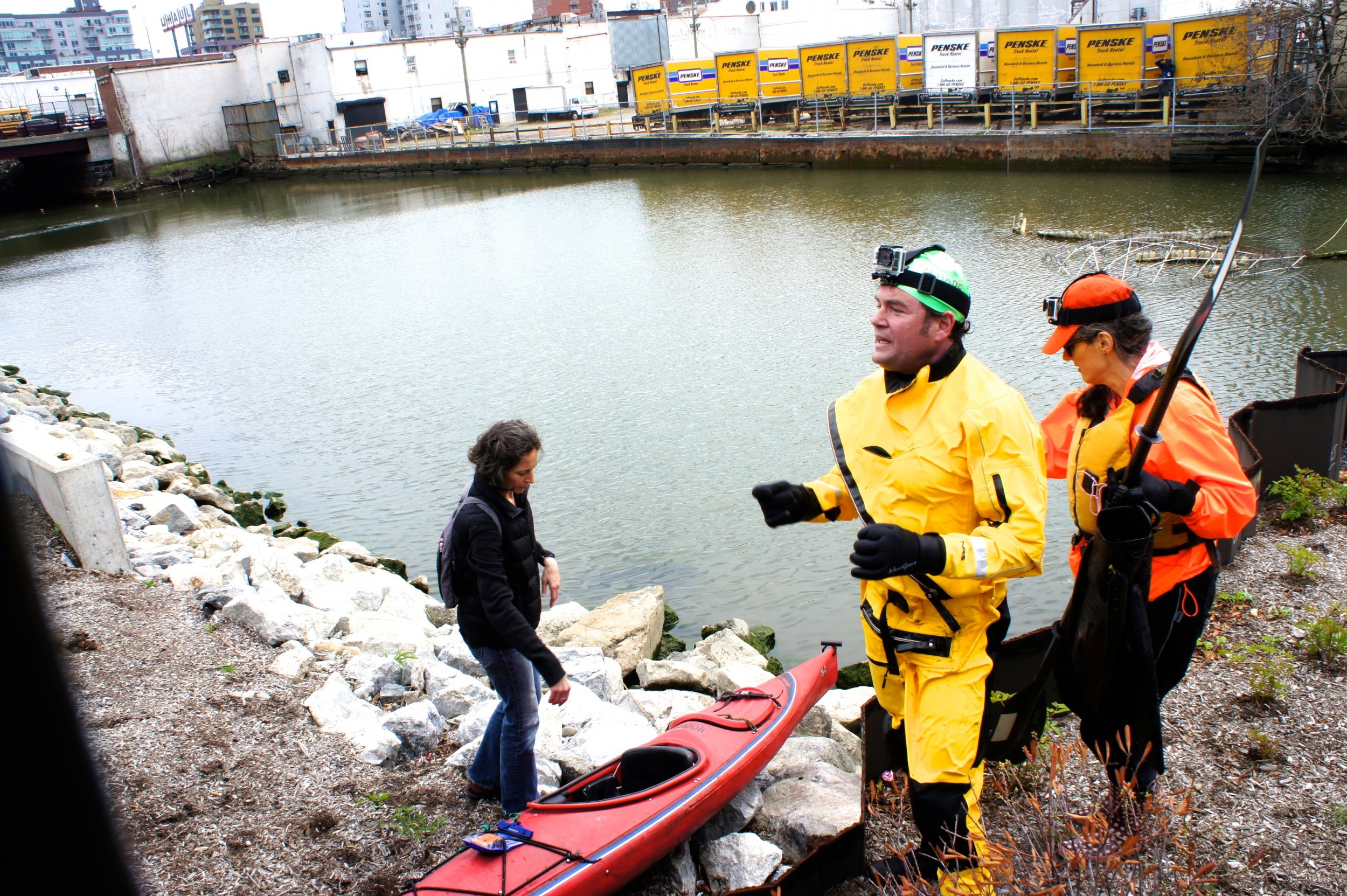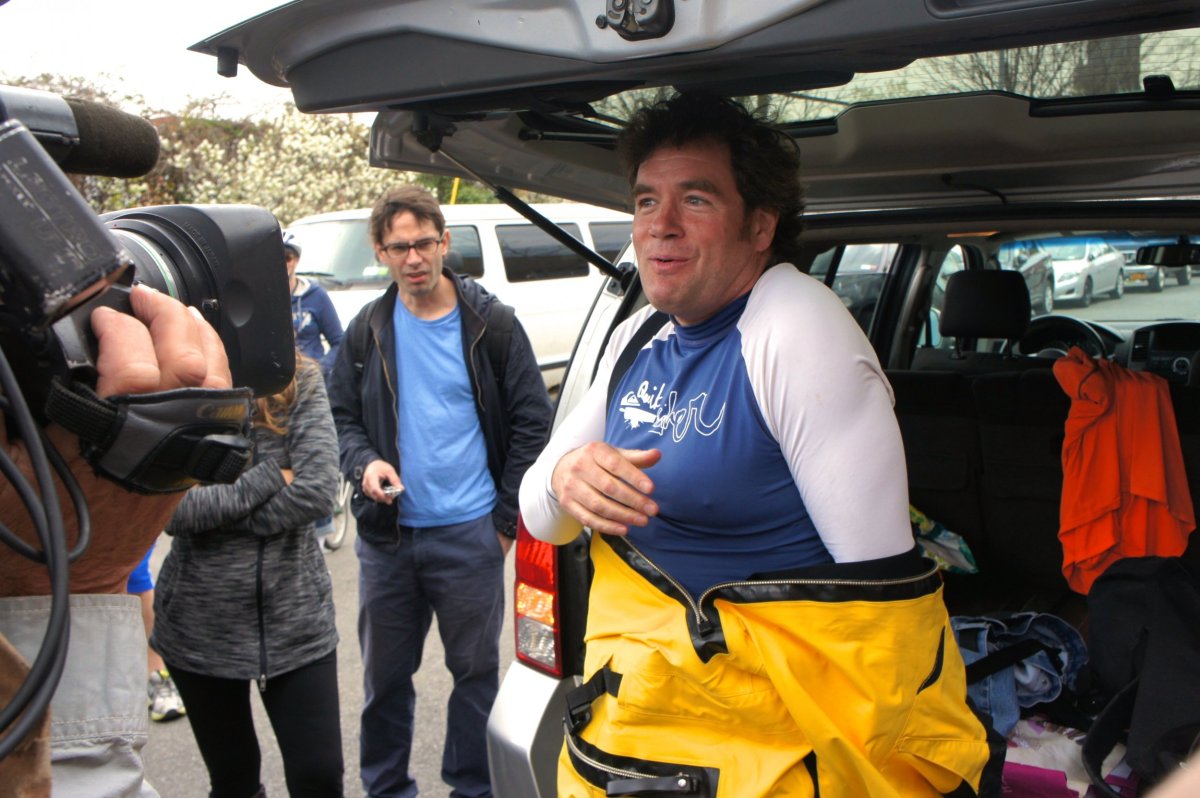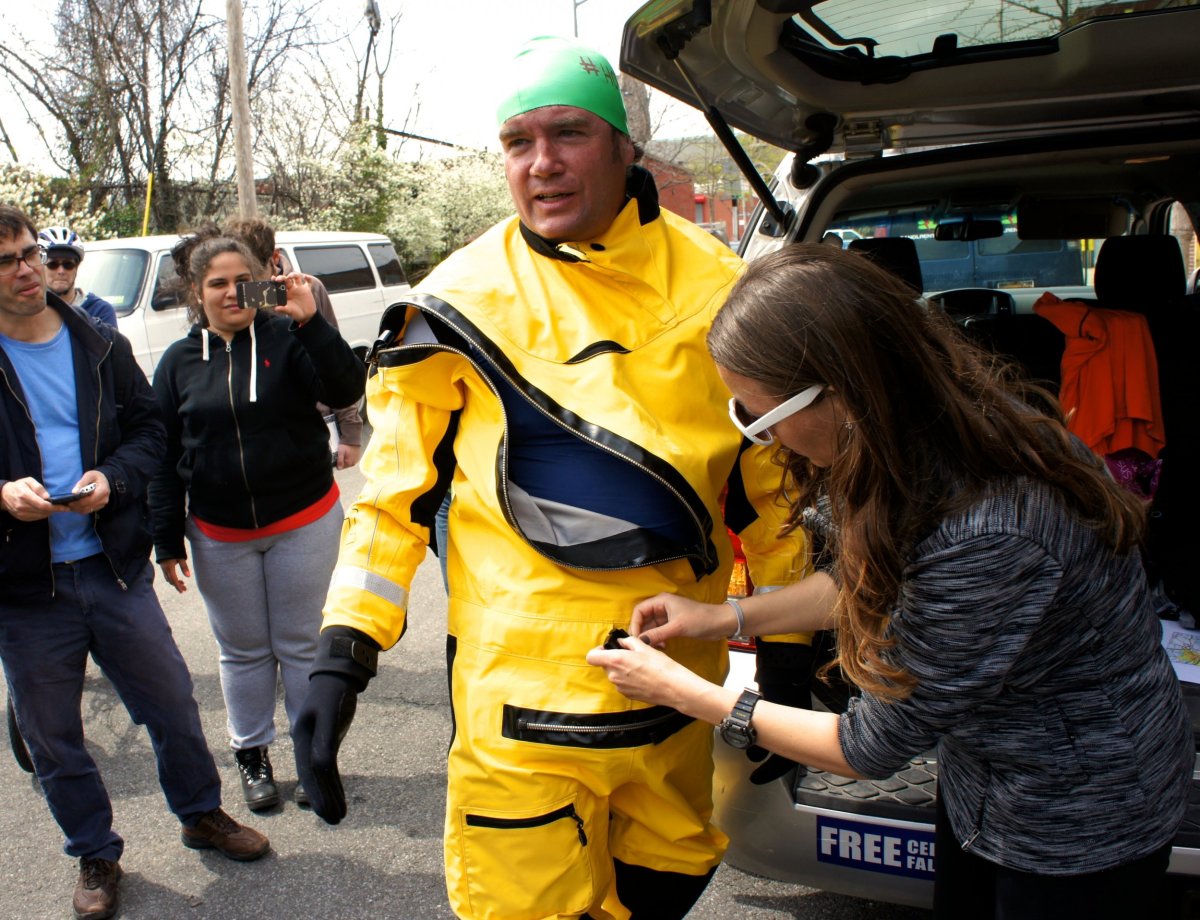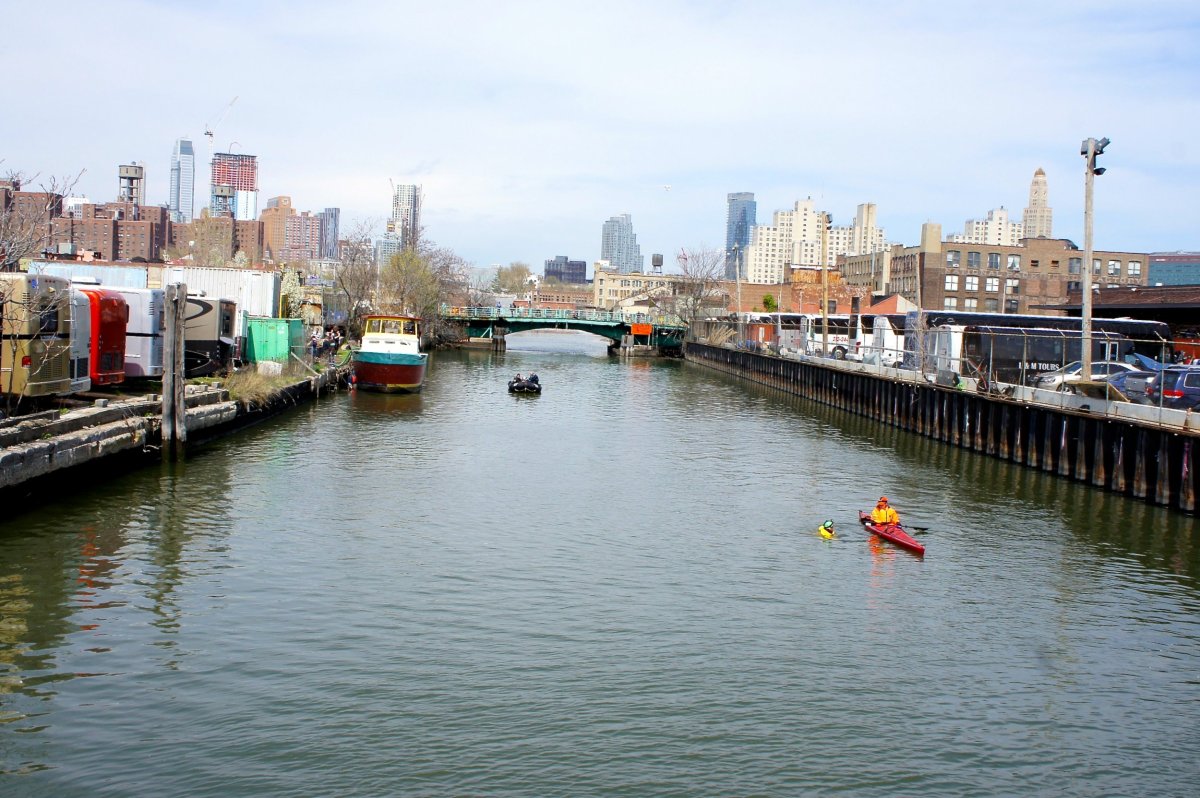
When you're preparing to jump into water laden with gonorrhea, dysentery, an array of cancer-causing compounds and raw sewage, it's best to take some precautions.
On Wednesday afternoon, Christopher Swain, 46, pulled on a bright-yellow dry suit in front of a gaggle of several dozen reporters on the bank of the Gowanus Canal in Brooklyn, New York. Then he slathered his face with water-resistant cream, donned swim goggles and popped in earplugs.
But Swain, who became the first person to intentionally submerge himself and then swim in what many consider the most heavily polluted body of water in the United States, had one problem: He needed to breathe. His mouth would have to remain uncovered, so he would need to do his best not to swallow any water as he swam. And swish hydrogen peroxide in his mouth after he got out, to kill any stowaway bacteria from the fecal matter very much present in the Gowanus.
"I could get diarrhea," he said. "But a certain amount of risk is inevitable with these things, or nothing changes."
Swain is shocked that there are hundreds of people waiting to see him swim "just here to see me die!" He jokes. pic.twitter.com/F9JeRLuYSr
— Zoë Schlanger (@zoeschlanger) April 22, 2015


Swain is a clean-water activist and environmental educator who swims dirty waterways for a living. Well, not for a living. He doesn't get paid. But he's made a very public career of it.
"I'm pretty broke right now," he says. "You don't get rich doing environmental education."
Swain says he loves when people call him crazy or irresponsible for swimming in toxic water.
"It gives me a chance to say, What's crazy is that the most polluted waterway in the United States is in the greatest city in the world. If we're the greatest city on Earth, let's clean this stuff up! Are you going to tell New Yorkers they can't do it? Hell yeah, we can clean it up, and we owe it to ourselves to do it."
Just before his swim, the U.S. Environmental Protection Agency (EPA) sent out a warning: Swimming in the Gowanus is a terrible idea.
As a reminder, the EPA strongly advises AGAINST swimming in the #Gowanus Canal. Read our fact sheet: http://t.co/glDxjidmF1 @newsweek
— US EPA - NJ,NY,PR,VI (@EPAregion2) April 22, 2015
"We did speak with him and reiterated our position. We strongly discourage people from swimming in the canal," Mary Mears, the acting public affairs director for EPA's Region 2 office in New York, told Newsweek on Wednesday before the swim. "The mud at the bottom is so badly contaminated that it's been designated a Superfund site. Secondly, there is sewage in that canal. It can cause very serious health problems."
But Swain says that's the point. He wants people to realize how severely contaminated the Gowanus is, and the absurdity of the fact that it sits "in the middle of one of the most expensive real estate areas in the country."
After some delay—the private landowner who originally agreed to let Swain exit the water and "decontaminate" himself with bleach on his property had backed out the last minute—Swain slipped into the canal a few dozen yards from its most inland point. The canal is a dead-end channel, adding substantially to its contamination woes: The sewage that enters during rainstorms has little opportunity to exit again.
And he's in. First dude to ever swim the Gowanus on purpose. (If he makes it.) pic.twitter.com/VXTns8aJKa
— Zoë Schlanger (@zoeschlanger) April 22, 2015
Gowanus swimmer has a most illustrative backdrop right now. pic.twitter.com/HsUX84KWSW
— Zoë Schlanger (@zoeschlanger) April 22, 2015

Crowds of spectators and reporters from dozens of news outlets lined the bridges that stretch over the narrow channel. Cars stopped to watch. One man paused his SUV on a bridge and rolled down his window. "What is he, crazy? That guy better clean off good," he said to no one in particular, shaking his head. But overall the mood was supportive, if delightfully grossed out. For New Yorkers, the Gowanus Canal's contamination has an almost mythic lore of grossness all its own. Could Swain reappear on the shore glowing green? It probably wouldn't surprise anyone.
People cheered as he swam leisurely by, accompanied by a woman in a kayak: his support staff. An NYPD scuba team trailed behind in an inflatable dinghy.
But soon the sky grew dark, and the wind picked up. It was about to rain. Just two-thirds of a mile into what was meant to be a 1.8-mile swim, Swain got out, gargled a bit of hydrogen peroxide and clambered up the bank onto some rocks. The city had suggested he stop and wait for a clearer day. Swain was disappointed, but promised to try again soon.
"No one is telling me to stop-- they are suggesting." Apparently the City will help him finish on a clearer day. pic.twitter.com/0VLagomC0c
— Zoë Schlanger (@zoeschlanger) April 22, 2015
So what does the Gowanus Canal taste like?
"Mud, poop, ground-up glass, grass and gasoline," Swain told reporters back onshore. He didn't swallow any water, but he certainly got a mouthful. "There was a gritty, sandy feeling in my mouth. Like after you drink one of those green juices."
Swain says he's encountered much worse. When he swam the Charles River in Boston, for example, he says he came across "fresh" fecal matter.
"The first thing you think when you swim through poop is, 'I think I smell nachos.' Or, 'I think I smell oranges.' And then it's not," he recalled cheerfully.

The Gowanus Canal was declared a federal Superfund site in 2011, and the federal government intends to dredge much of the toxic materials from the bottom of the canal. According to the EPA, as well as the Gowanus Canal Conservancy, a nonprofit environmental steward of the canal, the Superfund process is going swimmingly.
Or, as swimmingly as it can. It's a complicated task: There's a 10-foot layer of sludge rife with heavy metals and toxins that needs to be taken care of. The banks of the canal were once home to an array of heavy industries: Chemical plants, gas manufacturing facilities, cement makers, soap makers, tanneries, paint and ink factories and oil refineries used the canal as a dumping ground for untreated industrial waste and raw sewage for decades. The concentration of dissolved arsenic in the water is 60 times the level considered damaging to human health, and the canal sediments consist of other heavy metals like lead, iron, manganese, cadmium and zinc, as well as a host of carcinogens.
"The Gowanus Canal cleanup is going very smoothly and remarkably quickly. We need to do prep work from an engineering standpoint before the actual cleanup can begin. But I would say the work is going as well as can possibly be expected," Mears said.
But Swain says that isn't enough. The sludge is hardly the canal's only malady. To put it bluntly, it's got a free-flowing poop problem.
As we've previously noted, when it rains in New York City, raw sewage bypasses treatment plants and flows directly into city waterways. Even just one-twentieth of an inch of rainfall can overwhelm New York's aging sewer system and trigger the Combined Sewer Overflow (CSO) system, which discharges the rainwater and raw sewage into the many CSO outfalls dotting the edges of the city.
The Gowanus Canal has it especially bad. Thirteen CSO sites pour 355 million gallons of diluted raw sewage into the canal each year.
The Superfund plan intends to cut CSOs by 34 percent, but that will still leave roughly 234 million gallons per year of CSO sewage for the canal to cope with. Even with the Superfund, the Gowanus will still be absolutely disgusting.
Swain wants that to change. "Let's make the standard of clean mean safe enough to swim in every day. Let's change the way we think about 'cleaned up,'" he said. "This is a reminder that all Americans have the right to fish and swim in all navigable water. We deserve a Gowanus canal that is a jewel, a diamond that sparkles in the sun."
Then Swain wiped the back of his gloved hand on the top of a black metal fence behind him. A line of grease was left behind, sparkling in the sun.
This piece has been updated to reflect the correct volume of CSO discharge into the Gowanus Canal as recorded by the EPA, as well as the amount of CSO discharge projected to remain after the Superfund project concludes.
Uncommon Knowledge
Newsweek is committed to challenging conventional wisdom and finding connections in the search for common ground.
Newsweek is committed to challenging conventional wisdom and finding connections in the search for common ground.
About the writer
Zoë is a senior writer at Newsweek. She covers science, the environment, and human health. She has written for a ... Read more
To read how Newsweek uses AI as a newsroom tool, Click here.








